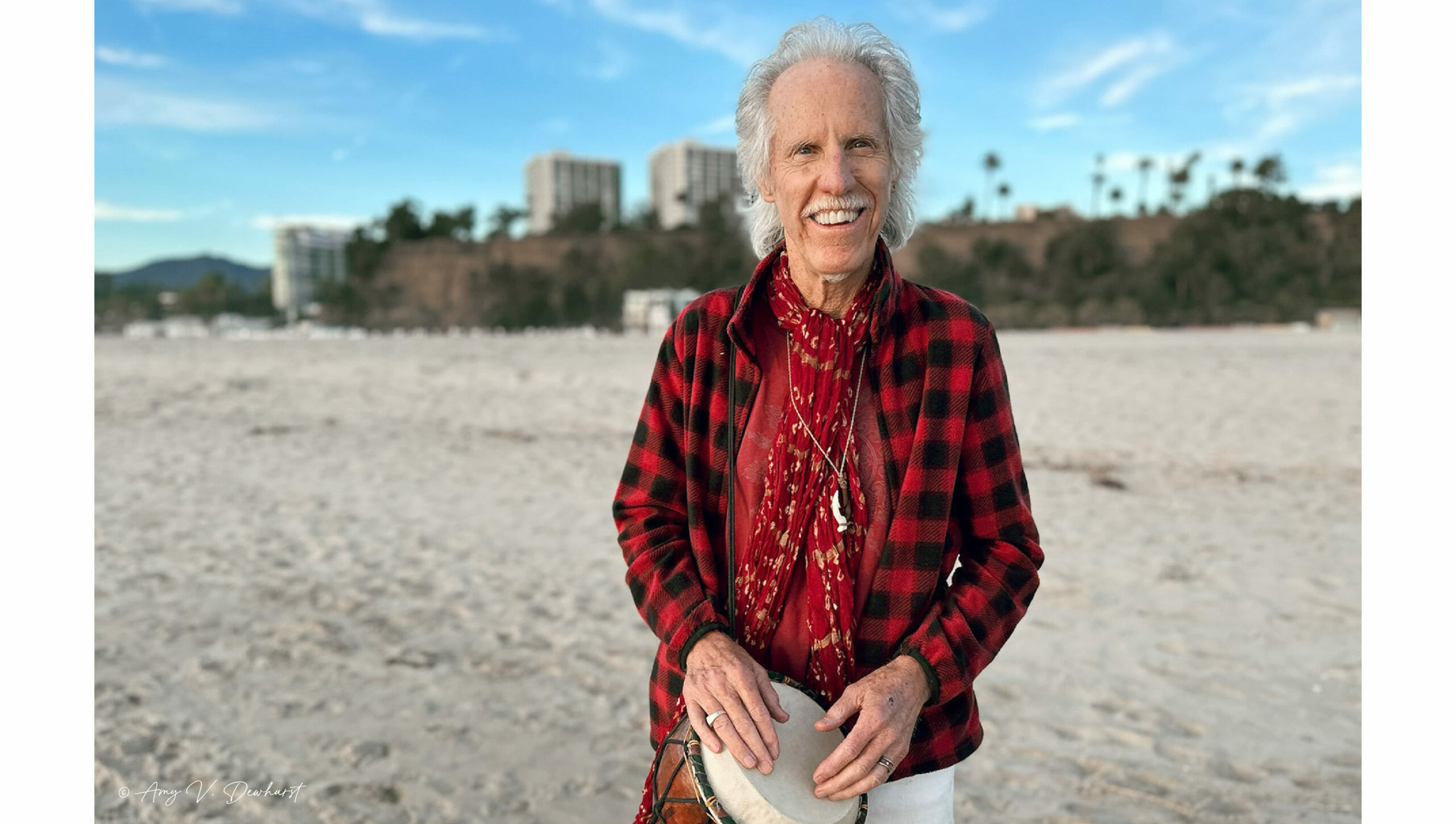It’s a winter sunset in Santa Monica.
John Densmore stands at the edge of the ocean. As the sky changes color, blue to yellow to crimson gold, he rhythmically taps a hand drum, and recites his own spoken word poetry, “And the Sun God Ra….!”
The cold waves rage closer towards his feet until he’s finally forced to move. He keeps the beat, as he treads backwards, casually mentioning, “Ya know this is where we wrote Moonlight Drive” He half-hums, half-sings the tune, “Let’s swim to the moon, let’s climb thru the tide…” The seagulls interpret this as a cue to take flight. A single feather floats down past his face. He lifts one eyebrow, giving a “Hm…what do you think that means?” look.
In the weeks prior Densmore inducted friends, The Jefferson Airplane, into the Hollywood Walk of Fame and played with Ringo Starr at Olivia Harrison’s LA book launch. But you wouldn’t hear it from him. No, he’s effortlessly weaving in and out of Harry Belafonte lyrics, political theory, environmental ethics, indigenous prayers and polite conversation, beating his drum all the while.
I ask if it’s true his childhood home was paved over to build part of the 405 highway. He laughs, “Yea, that’s good Amy, and I think [The Beach Boys’] Brian Wilson’s did too. Now wait a minute, let’s get metaphoric. My roots are a freeway on-ramp. That’s very LA, wouldn’t you say?” I nod in agreement.
God This Is The Stuff
In the Los Angeles suburb of Westwood, there’s a sign that says “San Diego Freeway North,” where the Densmore home once stood. A few blocks away is a still thriving Catholic parish. John’s mother would drag him and his sister to St. Timothy’s Church every Sunday morning. The septuagenarian recalls, “I went up to the balcony because I didn’t like the smell of frankincense. The mass was in Latin, so it was like, ‘What is this mumbling?’ and the drunken Irish organ player is just slamming away on the thing. I’m sitting alone up there, 10 benches, nobody but me, but the bench is rattling, it’s vibrating, it’s so loud. And for an eight-year-old, that was like acid. It was like heaven. It was like, ‘Wow, vibration!’ and it’s shaking my psyche and it plants music in my head. I’m like, ‘God, this is the stuff.’ So, all my young life, I was completely in love with music.”

Cool In Training Source; John Densmore
At around eight-and-a-half John’s parents rented him an upright piano. His pet parakeet Bill would practice with him, sitting or strutting on the keys, sometimes even singing along. Mrs. Densmore made sure John worked on what was assigned, and not just he and Bill’s arpeggio interpretations. He reflects “Even as a kid I knew that what made the difference between a great musician and an ok one was what was between the notes. Ya know, the feeling you give the silences and the sounds.”
The Densmores’ orthodontist advised against the clarinet, so the junior high band director suggested drums. Learning the nine rudiments on a rubber pad was borderline torture, but John loved the powerful feeling of sitting behind a kit. In the high school marching band the teen made his way through the bass, the cymbal and finally the snare. “It was so far back that being in a band wasn’t cool yet” he grimaces, “Being a jock was cool.”
Chasin’ The Trane
The marching band drummer gigged at local Catholic school dances, but bars and frat parties paid more. To appear of age, Densmore and his friend scored fake IDs in Tijuana. They used them to sneak into jazz clubs like the Lighthouse and Shelley’s Manne Hole. Densmore states proudly, “Kerouac and Cassidy saw Charlie Parker. We saw John Coltrane.”
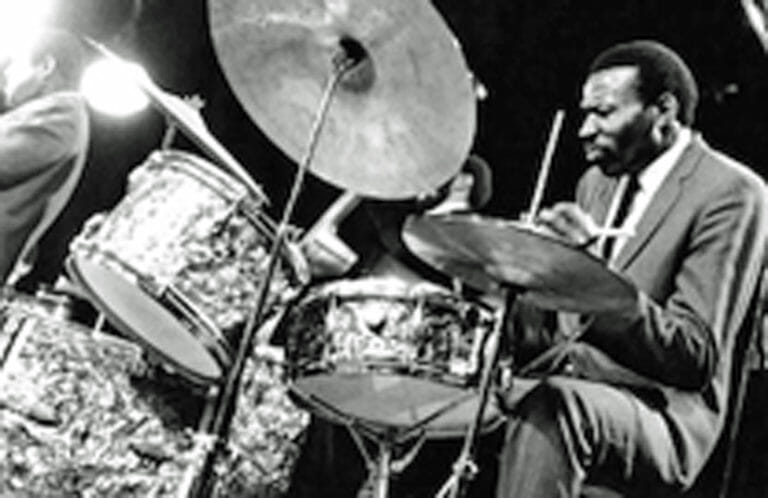
Jazz Machine Elvin Jones Source Getty Jones
The iconic jazz saxophonist John Coltrane was known for bringing listeners on a journey, transcending planes of consciousness, and seemingly changing the atomic structure of the air. John and Grant sat transfixed during a 30 minute rendition of “Chasin’ the Trane” in which Coltrane, and his drummer Elvin Jones were in telepathic conversation, making musical alchemy.
After one such set the underagers slinked backstage. John smirks, “We heard Coltrane say ‘Hotel’ to Elvin, and for the next few days all we could say to each other was ‘Hotel, hotel.”
Waiting For The Sun
The jazz freak attended Santa Monica City College and Cal State Northridge (then San Fernando Valley State College). “I loved music but never thought I could make a living at it.” He remarks, “I was a music major, got A’s, but then I changed to business because I wanted to make money. But I got D’s in business. That was trying to tell me something there.”
To keep up with the cats they jammed with, John and Grant tried LSD. Grant got caught in a Charles Mingus album cover while Densmore watched an Acacia Tree breathe. “Yea and acid was legal then,” he remarks, “Before I smoked any pot, I took acid. I had terror for the first five minutes. I was in the void or whatever, and then I saw God in every leaf for eight hours straight. Afterward nothing had changed and yet everything had.”
A few weeks later the duo reconnected with a buddy from high school days. Robby Krieger had been kicked out of private school and was living up in the Pacific Palisades at his parents’ place. He was a guitar player influenced by Robert [Crossroads] Johnson, and Jimmy Reed. Krieger turned them on to Dylan. They turned him on to LSD. Soon they all formed a band called “The Psychedelic Rangers” who dosed far more than they gigged.
Let My Love Open The Door
“The acid was shattering to the nervous system,” John recalls, “The silent guru, the one Peter Townsend likes, Meher Baba once wrote on his chalkboard ‘If drugs open the door, and leads disciples to me, that’s fine. They should close it after that.’ The meditation, the chanting, it’s a lower-slung longer journey, but it’s a sustainable one.”
Robby had heard of a Transcendental Meditation class being taught at the old Masonic Temple, off Santa Monica Boulevard in West LA. The group received their preliminary instruction from a TM teacher before being initiated by its founder the Maharishi Mahesh Yogi. John recalls, “This is a year or so before The Beatles discovered him. So we go to this little room, 40 people, and, oh my God, the love vibe is palpable. There’s this little guy in white with the beard and robes, and it was the antithesis of the vibe I got from a priest at Catholic school, with black outfits and the tight collar, and [he wags his finger] ‘You’re a sinner’ and oh, it just blew my mind. So, we started meditating.”
Maharishi Was Our Booking Agent
One day a self-assured UCLA grad student named Ray Manzarek and his girlfriend Dorothy attended the program. John retells, “And Ray kept saying, ‘No bliss, no bliss,’ because he was comparing it to acid, which is like, bam. And meditation, like chanting, it’s a long discipline. Ray comes up to me, “I hear you’re a drummer, you want to come down to my parents’ garage and jam?”
John was already in a few other bands but made his way to the Manzarek’s Manhattan Beach pad. He retells, “And Jim’s there and he’s so shy, it’s ridiculous. I think to myself, ‘This is not the next Mick Jagger,’ but then I get these words handed to me on a piece of paper, ‘Day destroys the night, night divides the day.’ Whoa, break on through to the other side, it was like hearing drum beats when I read them. And so that was the beginning.”
Ray’s brothers quit the band, and John brought Robby to a rehearsal. The two made a pact to let go of all their other projects and commit to this one. Densmore jokes, “I don’t think Maharishi knew it, but he was our booking agent. He put the band together.”
Stoned Immaculate
Jim Morrison was a UCLA film student, living on a Venice Beach rooftop, taking LSD and writing lyrics for a rock concert he saw in his head. Morrison wasn’t a musician. He was an introverted artist finding his voice literally and figuratively. The only band of the era to opt out of a bass player created a safe space for the singer to explore his sound. John remembers, “He would bring in these crumpled pieces of papers, coffee-stained napkins, and notebooks with incredible lyrics. He was talking about a connection to the void, the words were trying to tell us that there is something else.”
A couple miles East in the Densmore house, John placed a picture of the Hindu God Krishna, a candle, and a copy of Paramahansa Yogananda’s Autobiography of a Yogi on his bedside table. His new friends came over for a spaghetti dinner. To John’s relief, they were on their best behavior when Mr. Densmore asked if the boys had a name for their band.
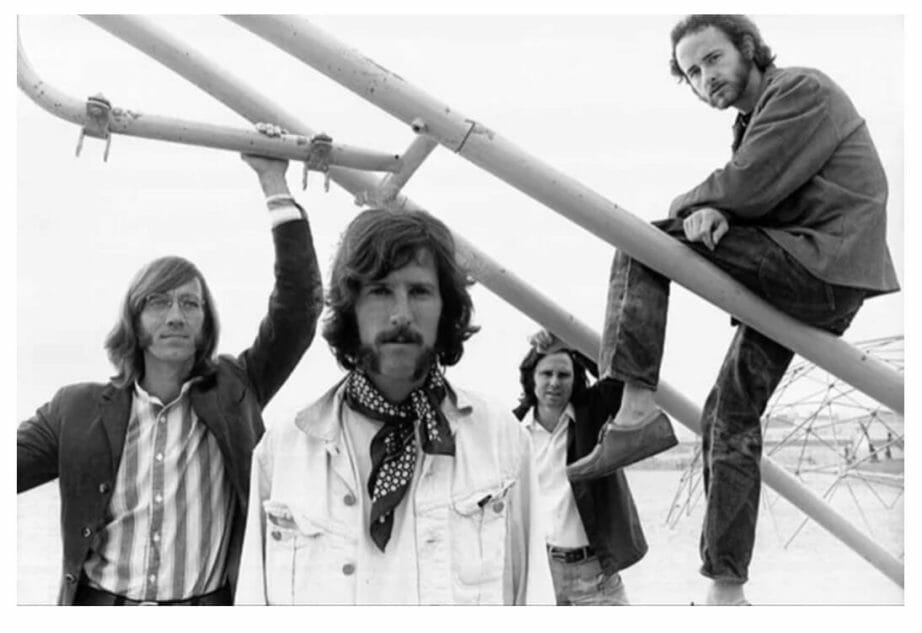
The Doors From Venice (L to R Ray Manzarek, John Densmore, Jim Morrison, Robby Krieger) c. Henry Diltz
Ray, John and Jim cruised South on the 405. Morrison shoeless in the passenger seat lit a joint and asked, “What do you think of the name ‘The Doors’?” Ray explained that Jim had gotten it from the Aldous Huxley book The Doors of Perception and Jim explained that Huxley got it from a William Blake poem that read, “If the doors of perception were cleansed everything would appear to man as it is, infinite.” Mr. Densmore responded, “The Doors’ is the worst name I ever heard for a band,” John boasted, “I told him that his reaction meant we were on the right track!” Soon after a marquee on the sunset strip changed its letters to read, ‘The Doors – The Band From Venice.”
I Guess I Like It Fine, So Far…
The Doors played the London Fog Club five hours a night, four nights a week. With about 30 songs developing including drafts and covers they had to find a way to fill the time. John thought to the unhurried improvisations of Coltrane and Jones. Ray thought to a Ravi Shankar album, of which his friend had designed the cover. Densmore exclaims, “Oh my God, it’s just so mystical long ragas. Which gave us the idea to break the three-minute [radio play] barrier, to do “Light My Fire” for seven minutes, “The End” for 10 minutes, and “When The Music’s Over” 11 minutes. So that came from ragas.” Years later John and Robby attended the Kinnara School of Music where they learned from the maestro, “Ravi was telling us, not literally, ‘You guys in America want to orgasm too quick. Take a long foreplay and you’ll have a bigger payoff.”
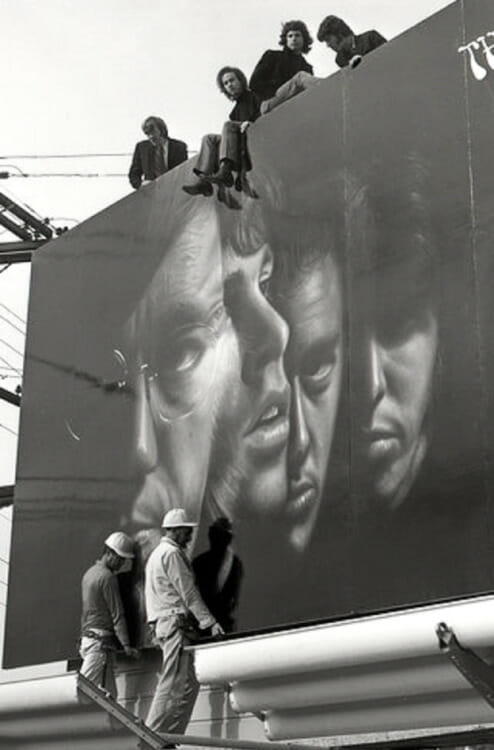
Best Seat In The Chateau Marmot Source; Unknown
The payoff came just hours before The Doors got fired from The Fog, when booker Ronnie Haran saw their set. She convinced her boss to make The Doors the house band at The Whiskey-A-Go-Go where they opened for popular acts including The Animals, The Rascals, The Turtles, Buffalo Springfield, Frank Zappa and The Mothers of Invention and even the Van Morrison fronted, Them.
Elektra offered The Doors a deal. Company president Jac Holzman bought a billboard on the Sunset Strip to announce their first album’s release, and by July of 1967 The Doors’ “Light My Fire” was #1 in the nation. John Densmore reflects, “Yea, I hoped to pay the rent for a decade. And as you can see, my hair is white and I’m still talking about it 50 years later. It was some kind of blessing. Something came through bigger than the four of us, and we needed this sort of, stable mattress of me and Ray and Robby to be the foundation for Jim to be on top of psychically and sonically.”
We Got The Numbers
Between 1966 and 1971, The Doors played more than 350 shows in the US, Canada, Mexico and Europe. This included iconic venues such as Ondine’s Discoteque, The Fillmore East and West, The Avalon and Winterland Ballrooms, The Hollywood Bowl, Madison Square Garden, and the Isle Wight Festival in East Afton Farm, England. Six Consecutive albums; The Doors, Strange Days, Waiting for the Sun, The Soft Parade, and Morrison Hotel went certified platinum (and sometimes multi-platinum) in the United States and platinum, gold and silver internationally.
The Doors’ massive popularity was likened to a Dionysian Feast. The once-cautious lead-singer’s anti-authoritarian, freedom-at-all-costs ethos were fully expressed when he didn’t change lyrics for a network television censor, and when he became the first rock performer to be arrested on stage. Charges required multiple venues to cancel already scheduled shows. Frenzied fans protested. The band braced for impact. The self-proclaimed “Lizard King” questioned the honor of the American judicial system and the sanctity of the first amendment.
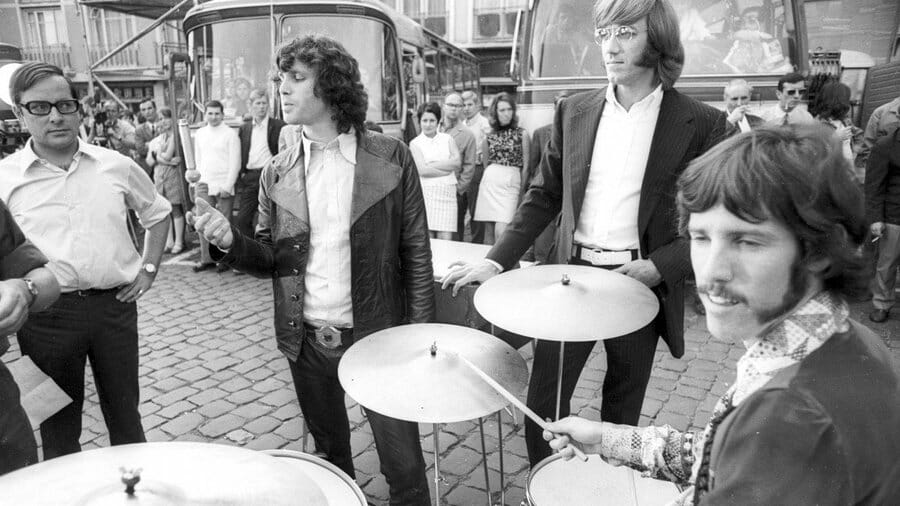
Riders On The Storm In Europe Source; Unknown
John admits, “So yeah. It was hard. Jim was not easy, let me tell you. I lobbied for a year to stop playing live, because it was so great, and then it got not great due to his self-destruction. We knew there was a big elephant in the room, we didn’t know he had a disease, alcoholism.”
Everything Would Appear To Man As It Is, Infinite
As a birthday gift a friend bought Morrison time at the Village Recorder. A studio built in the old Masonic Temple off Santa Monica Boulevard, where John and Robby first met Ray at the TM training. Jim recorded his spoken-word poems, from An American Prayer. He reads, “We live, we die and death not ends it…”
Eight months later a report came in from Paris that Morrison had slipped off into the infinite. Forever 27.
John reflects, “So yeah, I was on a rocket ship. It was exciting. I’m proud of it, but I’m glad that meditation and yoga, Robert Bly men’s work and whatever other stuff helped the rocket ship landing not be so bumpy. Because at the downside of that peak, some folks died. Well, many.”
The Other Side
On the Santa Monica sands, the winter winds whip. The 78-year-old continues to tap his hand drum while he extolls, “Carl Jung said that the first half of your life you’re out there doing a lot of stuff and the second half of your life you’re analyzing what the hell did it all that mean?”
I ask if he’s talking about the Jung quote, “The first half of life is devoted to forming a healthy ego, the second half is going inward and letting go of it.” He grins, still drumming and says, “Yea, that’s the one.”
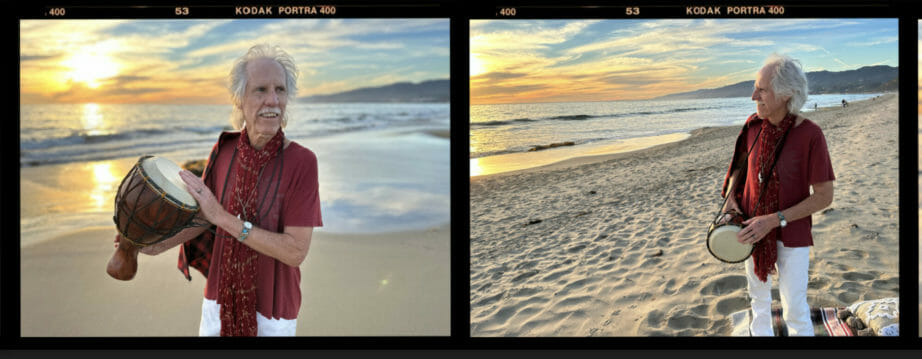
Bloody Red Sun Of Fantastic LA c. Amy V. Dewhurst
John’s ability to translate deep teachings and dark meanings is in-part what has always made his artistic expressions so captivating. His first post-Doors memoir Riders on the Storm was a New York Times Bestseller and source material for the Oliver Stone cult-classic film, The Doors. His second work The Doors Unhinged has become required reading for music business majors in universities across the country.
The Seekers
John Densmore’s latest offering, The Seekers, is a special kind of book. A trojan horse of spirituality in which he layers ancient wisdom, lessons learned and thought-provoking prose inside entertaining rockstar stories. Inspired by Gurdjieff’s 1927 classic Meetings with Remarkable Men and insisted upon by friends and family, the easy-read is nothing short of magnificent.
Within it John thanks teachers like Robert Bly, Peggy Feury, Fred Katz and even his junior high band leader, Mr. Armour. He pays homage to great instrumentalists like Ravi Shankar and Emil Richards. He tells legendary Laurel Canyon tales like Van Morrison working out the words to his seminal album, Astral Weeks. He talks about the time he got kicked out of a Jamaican recording studio by a then-unknown Jimmy Cliff and weeping when he read Laurie Anderson’s good-bye letter to her husband Lou Reed. Densmore somehow segues from jazz drummer Elvin Jones to beloved Pushti Marg scholar Shyamdas in the same sentence. And oh yeah, there was that time he smoked a joint with Willie Nelson. Naturally.

‘Til The Stars Fall From The Sky… c. Amy V. Dewhurst
Fan favorite passages include musician Tom Petty’s reflection on Jim Morrison’s well-lived life; “Tom said, ‘Some artists, the very very great ones, come along with the flame turned all the way up. And the flame is all the way up and you use a lot of fuel fast. And you’ve just got to get the heat that comes off of it.”.
John’s appreciation for the godmother of punk, Patti Smith giving it all up to raise her family, “[Patti] became a mother and a housewife. What? The woman who wrote ‘Jesus died for somebody’s sins but not mine,’ had settled down in the Midwest?! At first it seemed unthinkable, but it was a heroic move.”
And the last moments with his mother on the Earth plane, “They had obviously told her I was on my way because she was lying in her bed, all decked out with turquoise earring, a turquoise necklace, and slightly smeared lipstick. A ninety-four-year-old woman still wanting to look good for her son is an image that will stay with me forever.”
Amongst the Hafiz quotes, Gita passages, Ram Dass moments, and Neil De Grassi Tyson data Densmore assures the reader,“I have had the opportunity to meet and interact with some extraordinary people. To be a member of The Doors and have the unusual access I have been afforded is one of the greatest blessings of my life. But what I’ve learned is that anyone can access magical moments these gifted artists live in.”
Back on the beach in Santa Monica he shares, “I play hand drums and read poetry at small events, and some nights it’s so powerful because the audience and I are so connected. It’s as exciting as Madison Square Garden.”
What You Seek Is Seeking You
The sun takes its time syncing into the Pacific.
John Densmore pauses for a moment, breathes in the crisp cool air. He rat-a-tat-tats out a few final beats, turns to me and says, “Ya know Joseph Campbell said, ‘The goal in life is to make your heartbeat match the beat of the universe.’”
I think to myself, “Seems like you have that one figured out…”
As though he heard the thought he shrugs.
I smile.
At the same time we both start humming “Let’s swim to the moon, let’s climb thru the tide…”

Heartbeat of the Universe, John Densmore c. Amy V. Dewhurst
Join John Densmore at Vroman’s Bookstore in Pasadena
The Seekers Book Reading + Signing
Friday December 16, 2022
7pm
For tickets click here
The Seekers is now available where all books are sold
Click here to purchase.
Click here to learn more at Hachette Books.
To keep up with John Densmore
Check out his website, JohnDensmore.Com
Follow John on Social; Facebook , Instagram.
To Check Out Amy’s Work Go To; Sense + Color, You Can Reach Her At IG: Amy_V_Dewhurst + AmyVDewhurst@SenseAndColor.co #PutYourGoodWhereItWillDoTheMost

